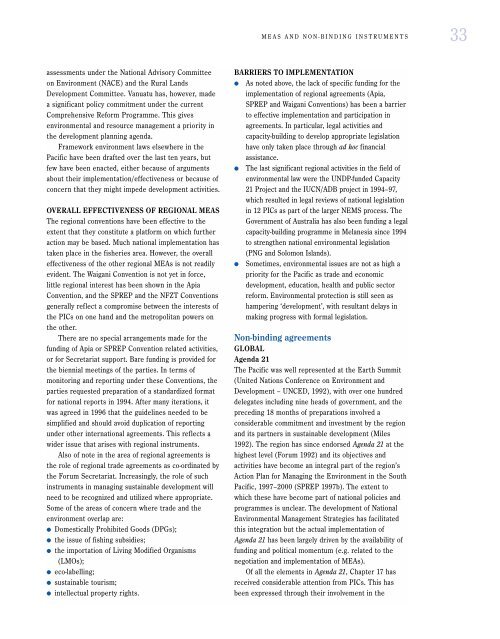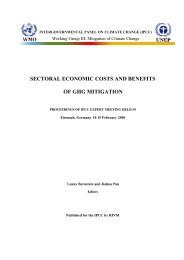Pacific Islands Environment Outlook - UNEP
Pacific Islands Environment Outlook - UNEP
Pacific Islands Environment Outlook - UNEP
Create successful ePaper yourself
Turn your PDF publications into a flip-book with our unique Google optimized e-Paper software.
MEAS AND NON-BINDING INSTRUMENTS 33<br />
assessments under the National Advisory Committee<br />
on <strong>Environment</strong> (NACE) and the Rural Lands<br />
Development Committee. Vanuatu has, however, made<br />
a significant policy commitment under the current<br />
Comprehensive Reform Programme. This gives<br />
environmental and resource management a priority in<br />
the development planning agenda.<br />
Framework environment laws elsewhere in the<br />
<strong>Pacific</strong> have been drafted over the last ten years, but<br />
few have been enacted, either because of arguments<br />
about their implementation/effectiveness or because of<br />
concern that they might impede development activities.<br />
OVERALL EFFECTIVENESS OF REGIONAL MEAS<br />
The regional conventions have been effective to the<br />
extent that they constitute a platform on which further<br />
action may be based. Much national implementation has<br />
taken place in the fisheries area. However, the overall<br />
effectiveness of the other regional MEAs is not readily<br />
evident. The Waigani Convention is not yet in force,<br />
little regional interest has been shown in the Apia<br />
Convention, and the SPREP and the NFZT Conventions<br />
generally reflect a compromise between the interests of<br />
the PICs on one hand and the metropolitan powers on<br />
the other.<br />
There are no special arrangements made for the<br />
funding of Apia or SPREP Convention related activities,<br />
or for Secretariat support. Bare funding is provided for<br />
the biennial meetings of the parties. In terms of<br />
monitoring and reporting under these Conventions, the<br />
parties requested preparation of a standardized format<br />
for national reports in 1994. After many iterations, it<br />
was agreed in 1996 that the guidelines needed to be<br />
simplified and should avoid duplication of reporting<br />
under other international agreements. This reflects a<br />
wider issue that arises with regional instruments.<br />
Also of note in the area of regional agreements is<br />
the role of regional trade agreements as co-ordinated by<br />
the Forum Secretariat. Increasingly, the role of such<br />
instruments in managing sustainable development will<br />
need to be recognized and utilized where appropriate.<br />
Some of the areas of concern where trade and the<br />
environment overlap are:<br />
● Domestically Prohibited Goods (DPGs);<br />
● the issue of fishing subsidies;<br />
● the importation of Living Modified Organisms<br />
(LMOs);<br />
● eco-labelling;<br />
● sustainable tourism;<br />
● intellectual property rights.<br />
BARRIERS TO IMPLEMENTATION<br />
● As noted above, the lack of specific funding for the<br />
implementation of regional agreements (Apia,<br />
SPREP and Waigani Conventions) has been a barrier<br />
to effective implementation and participation in<br />
agreements. In particular, legal activities and<br />
capacity-building to develop appropriate legislation<br />
have only taken place through ad hoc financial<br />
assistance.<br />
● The last significant regional activities in the field of<br />
environmental law were the UNDP-funded Capacity<br />
21 Project and the IUCN/ADB project in 1994–97,<br />
which resulted in legal reviews of national legislation<br />
in 12 PICs as part of the larger NEMS process. The<br />
Government of Australia has also been funding a legal<br />
capacity-building programme in Melanesia since 1994<br />
to strengthen national environmental legislation<br />
(PNG and Solomon <strong>Islands</strong>).<br />
● Sometimes, environmental issues are not as high a<br />
priority for the <strong>Pacific</strong> as trade and economic<br />
development, education, health and public sector<br />
reform. <strong>Environment</strong>al protection is still seen as<br />
hampering ‘development’, with resultant delays in<br />
making progress with formal legislation.<br />
Non-binding agreements<br />
GLOBAL<br />
Agenda 21<br />
The <strong>Pacific</strong> was well represented at the Earth Summit<br />
(United Nations Conference on <strong>Environment</strong> and<br />
Development – UNCED, 1992), with over one hundred<br />
delegates including nine heads of government, and the<br />
preceding 18 months of preparations involved a<br />
considerable commitment and investment by the region<br />
and its partners in sustainable development (Miles<br />
1992). The region has since endorsed Agenda 21 at the<br />
highest level (Forum 1992) and its objectives and<br />
activities have become an integral part of the region’s<br />
Action Plan for Managing the <strong>Environment</strong> in the South<br />
<strong>Pacific</strong>, 1997–2000 (SPREP 1997b). The extent to<br />
which these have become part of national policies and<br />
programmes is unclear. The development of National<br />
<strong>Environment</strong>al Management Strategies has facilitated<br />
this integration but the actual implementation of<br />
Agenda 21 has been largely driven by the availability of<br />
funding and political momentum (e.g. related to the<br />
negotiation and implementation of MEAs).<br />
Of all the elements in Agenda 21, Chapter 17 has<br />
received considerable attention from PICs. This has<br />
been expressed through their involvement in the

















